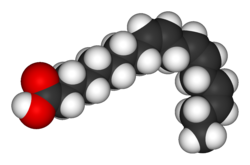Alpha-Linolenic acid
 |
|
| Names | |
|---|---|
|
IUPAC name
(9Z,12Z,15Z)-9,12,15-Octadecatrienoic acid
|
|
| Other names
ALA; Linolenic acid; cis,cis,cis-9,12,15-Octadecatrienoic acid; (9Z,12Z,15Z)-octadeca-9,12,15-trienoic acid; Industrene 120
|
|
| Identifiers | |
|
463-40-1 |
|
| 3D model (Jmol) |
Interactive image Interactive image |
| ChEBI |
CHEBI:27432 |
| ChEMBL |
ChEMBL8739 |
| ChemSpider |
4444437 |
| DrugBank |
DB00132 |
| ECHA InfoCard | 100.006.669 |
| 1049 | |
| PubChem | 5280934 |
| UNII |
0RBV727H71 |
|
|
|
|
| Properties | |
| C18H30O2 | |
| Molar mass | 278.44 g·mol−1 |
| Density | 0.9164 g/cm3 |
|
Except where otherwise noted, data are given for materials in their standard state (at 25 °C [77 °F], 100 kPa).
|
|
|
|
|
| Infobox references | |
α-Linolenic acid (ALA) is an n−3 fatty acid. It is one of two essential fatty acids (the other being linoleic acid), so called because they are necessary for health and cannot be produced within the human body. They must be acquired through diet. ALA is an omega-3 fatty acid found in seeds (chia, flaxseed, hemp, see also table below), nuts (notably walnuts), and many common vegetable oils. In terms of its structure, it is named all-cis-9,12,15-octadecatrienoic acid. In physiological literature, it is listed by its lipid number, 18:3, and (n−3); its isomer GLA is 18:3 (n−6).
α-Linolenic acid is a carboxylic acid with an 18-carbon chain and three cis double bonds. The first double bond is located at the third carbon from the methyl end of the fatty acid chain, known as the n end. Thus, α-linolenic acid is a polyunsaturated n−3 (omega-3) fatty acid. It is an isomer of gamma-linolenic acid (GLA), a polyunsaturated n−6 (omega-6) fatty acid.
α-Linolenic acid was first isolated by Rollett as cited in J. W. McCutcheon's synthesis in 1942, and referred to in Green and Hilditch's 1930s survey. It was first artificially synthesized in 1995 from C6 homologating agents. A Wittig reaction of the phosphonium salt of [(Z-Z)-nona-3,6-dien-1-yl]triphenylphosphonium bromide with methyl 9-oxononanoate, followed by saponification, completed the synthesis.
Seed oils are the richest sources of α-linolenic acid, notably those of chia, perilla, flaxseed (linseed oil), rapeseed (canola), and soybeans. α-Linolenic acid is also obtained from the thylakoid membranes in the leaves of Pisum sativum (pea leaves). Plant chloroplasts consisting of more than 95 percent of photosynthetic thylakoid membranes are highly fluid due to large abundance of linolenic acid, that shows up as sharp resonances in high resolution carbon-13 NMR spectra, invariably. Some studies state that ALA remains stable during processing and cooking. However, other studies state that ALA might not be suitable for baking, as it will polymerize with itself, a feature exploited in paint with transition metal catalysts. Some ALA may also oxidize at baking temperatures. ALA percentages in the table below refer to the oils extracted from each item.
...
Wikipedia
